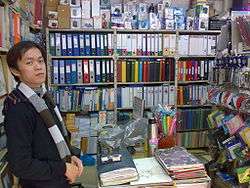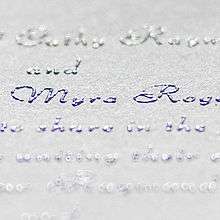Stationery

Stationery is a mass noun referring to commercially manufactured writing materials, including cut paper, envelopes, writing implements, continuous stationery, and other office supplies.[1] Stationery includes materials to be written on by hand (e.g., letter paper) or by equipment such as computer printers.
Countries with mass production
Many countries produce stationery, with China and Japan being the most known. Other countries, such as Bangladesh, have mainly stationery based on Chinese and Japanese cultures.
History of stationery
Originally the term stationery referred to all products sold by a stationer, whose name indicated that his book shop was on a fixed spot, usually near a university, and permanent, while medieval trading was mainly carried on by itinerant peddlers (including chapmen, who sold books) and others (such as farmers and craftsmen) at markets and fairs. It was a special term used between the 13th and 15th centuries in the manuscript culture. The Stationers' Company formerly held a monopoly over the publishing industry in England and was responsible for copyright regulations.
In its modern sense including personal writing materials, stationery has been an important part of good social etiquette, particularly since the Victorian era. Some uses of stationery, such as sending a manufactured reply card to a wedding invitation, have changed from offensive to appropriate.
The use and marketing of stationery is being partly superseded by electronic media. Stationery is intrinsically linked to paper and the process of written, personalized communication, and many techniques of stationery manufacture are employed, of varying desirability and expense. The most familiar of these techniques are letterpress printing, embossing, engraving and thermographic printing (often confused with thermography). Flat printing and offset printing are regularly used, particularly for low-cost or informal needs.
Uses of stationery
Printing
Letterpress

Letterpress is a method of printing many identical copies that requires characters being impressed upon the page. The print may be inked or blind but is typically done in a single color. Motifs or designs may be added as many letterpress machines use movable plates that must be hand-set.
Single documents
When a single document needs to be produced, it may be handwritten or printed typically by a computer printer. Several copies of one original can be produced by some printers using multipart stationery. Typing with a typewriter is obsolescent, having been largely superseded by preparing a document with a word processor and printing.
Thermographic

Thermographic printing is a process that involves several stages but can be implemented in a low-cost manufacturing process. The process involves printing the desired designs or text with an ink that remains wet, rather than drying on contact with the paper. The paper is then dusted with a powdered polymer that adheres to the ink. The paper is vacuumed or agitated, mechanically or by hand, to remove excess powder, and then heated to near combustion. The wet ink and polymer bond and dry, resulting in a raised print surface similar to the result of an engraving process.
Embossing

Embossing is a printing technique used to create raised surfaces in the converted paper stock. The process relies upon mated dies that press the paper into a shape that can be observed on both the front and back surfaces.
Engraving

Engraving is a process that requires a design to be cut into a plate made of a relatively hard material. It is a technology with a long history and requires significant skill and experience. The finished plate is usually covered in ink, and then the ink is removed from all of the un-etched portions of the plate. The plate is then pressed into paper under substantial pressure. The result is a design that is slightly raised on the surface of the paper and covered in ink. Due to the cost of the process and expertise required, many consumers opt for thermographic printing, a process that results in a similarly raised print surface, but through different means at less cost.
Classifications
- Desk top instruments: hole punch, Stapler and staples, tapes and dispenser,
- Drawing instruments: brushes, colour pencils, crayons, water colour,
- Erasers
- Ink and toner:
- Dot matrix printer's ink ribbon
- Inkjet Ink cartridge
- Laser printer toner
- Photocopier toner
- Filing and storage:
- Expandable file
- File folder
- Hanging file folder
- Index cards and files
- Two-pocket portfolios
- Mailing and shipping supplies:
- Paper and pad:
- Notebooks, wirebound notebook, writing pads, college ruled paper, wide ruled paper,
- Office paper: dot matrix paper, inkjet paper, laser paper, Photocopy paper.
- Writing instruments: ballpoint pen, fountain pen, pencil, porous point pen, rollerball pen, highlighter pen
School supplies
Many shops that sell stationery also sell other school supplies for students in primary and secondary education, including pocket calculators, display boards, compasses and protractors, lunchboxes, and the like.[2][3]
Retail dollar sales of back-to-school products from the office super stores grew 2 percent in August 2010 compared to August 2009, after July 2010 showed flat performance. The back-to-school season for school supplies had its best performance in the latter half of August, as many consumers waited until the last minute to purchase their supplies.[4]
See also
- Office supplies
- Crane & Co.
- List of stationery topics
- New Zealand standard for school stationery
- Ryman
- Shoplet
- Smythson
- teNeues
- WHSmith
References
- ↑ Peter Beal, ed., "Stationery", A Dictionary of English Manuscript Terminology, 1450–2000 (Oxford: Oxford University Press, 2008 [2011 online]).
- ↑ Streamlined Sales Tax Project "Definitions for School Related Supplies: SSTP Recommendations for Amendment to Agreement; July 29, 2004"
- ↑ Virginia Department of Taxation "School Supplies and Clothing FAQs"
- ↑ A Late Back-To-School Season Shows Modest Recovery for the Office Supplies Industry, by The NPD Group: https://www.npd.com/wps/portal/npd/us/news/press-releases/pr_100916/
External links
 The dictionary definition of stationery at Wiktionary
The dictionary definition of stationery at Wiktionary Media related to Stationery at Wikimedia Commons
Media related to Stationery at Wikimedia Commons